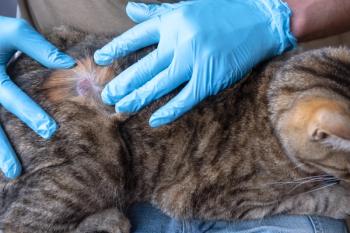
Consolidation heating up; generational issues add fuel
Solo practitioners could become a rare breed. As Baby Boomer veterinarians near retirement, their younger, supposed successors are resisting added responsibility, experts say.
Solo practitioners could become a rare breed.
As Baby Boomer veterinarians near retirement, their younger, supposed successors are resisting added responsibility, experts say.
"Generation X doesn't necessarily want the reins of ownership," says Dr. Michael Terry, practice broker for Plains States Professional Practice Sales and Services in Pomona, Kan. "That means fewer buyers are coming into the marketplace."
LoganJordan
The solution may be consolidation. And, although the market for merging is currently lethargic, the climate appears ripe for a shift, experts say.
"The concept of consolidation is alive - and growing, just not at a rampant pace," says Logan Jordan, an instructor with the American Animal Hospital Association's Veterinary Management Institute, a four-module, management education program for veterinary professionals at Purdue University. "Consolidation is going to gain increasing popularity because of the economics of it, the ability to share technology and get better working hours, sharing fixed costs."
Flurry of activity
Dr. Dick Goebel, broker for Simmons & Associates Great Lakes in West Lafayette, Ind., recently negotiated one private practice consolidation and is in the process of closing a second one.
"The opportunity for consolidation is great and I've been a real advocate for it," Goebel says. "But consolidation is under-appreciated. When people understand the message and appreciate the advantages, they're certainly more open."
One of Goebel's mergers took place among younger practitioners, one of whom recently graduated and bought a practice last year. He merged with another local practice that was a partnership of a younger and older practitioner.
"It's interesting that it was the new generation of practice owner who wanted to merge," says Goebel. "In fact, he got a little static from the former owner of retirement age who was still working on a part-time basis. He was trying to actively block the merger from occurring."
Hard data inaccessible
While mergers such as Goebel's are likely cropping up more frequently, especially in smaller communities, brokers as well as national organizations such as the American Veterinary Medical Association to date don't track actual numbers of private practice consolidations.
"There is no gatekeeper for those statistics," says Terry. "Practitioners approach each other, talk to an attorney and come up with a deal. What we have is anecdotal evidence of what we hear is going on in the marketplace."
What's the wait?
Any word of consolidations that reaches practice broker John Morrow's desk, in Tempe, Ariz., always involves the corporate sector. Yet he says he's a "firm believer" private practitioners should follow suit, although they tend to wallow.
"Practitioners definitely are hesitant primarily because they are pretty protective. They don't really -even beyond mergers and consolidations - tend to share much information with their colleagues, especially if they're within that competitive geographical area," Morrow says.
Goebel, a graduate of the '60s, says one of the major barriers to more consolidations in the private sector may be generational. Many of his generation just can't give up their practice so easily, he says.
"Their identity is so wrapped up in what they do that they can't imagine doing anything else," Goebel says.
He says many older practitioners also may carry longstanding professional jealousies.
"Some old timers never did get along with their colleague, or maybe they were former partners and there was a bitter partnership break. They can't imagine working together in a merged situation," he says.
Advantages
Often, experts say practitioners just aren't fully aware of the array of advantages consolidation offers:
- Ability to better equip practice. "If you consolidate a practice, you don't need two X-ray machines in two practices; you can get by with one piece of equipment," says Jordan.
Adds Dr. Jim Stephenson, broker of Simmons & Associates Northeast in Maine, "You'll have less equipment overall, but better in general -- an opportunity to have more specialized equipment."
Dr. Jim Stephenson
- Streamlined employee base.
- Ability to accommodate work schedules and lifestyle. "With (many) of the veterinarians coming out of school, they don't want to devote every waking hour to the development and maintenance of a practice," says Jordan.
- Improved bottom line. "If the consolidating practices bring more than 60-80 percent of clients into the merged hospital, they're not bringing any of the fixed costs with that. A lot of the increased revenue falls straight to the bottom line and increases profitability quickly," says Morrow.
- Price breaks on drugs. Stephenson says practices may be able to take advantage of greater price-break bulk purchase savings in regard to drugs and supplies.
Drawbacks
While positives are many, experts will advise that consolidation is not for everyone. Drawbacks include:
- Competitive factors. "There are some concerns that there may be some competitive vacuums left open," says Stephenson. "For instance if two facilities combine into one there may be a geographic area that might be attractive for another practice to expand into."
- Loss of control. "Individual practitioners or two- to three-person shops, as you take on additional partners, you lose some degree of control," says Jordan.
- Less managerial individuality. "If a consolidated practice gets too big, you lose some local managerial attention and pride, potentially. A big city with 20 practices all over the city is getting a little more like a franchise," Jordan adds.
- Cultural clash. "There's potential for a cultural clash where the two practices are so far apart in style of medicine and culture of practice that it doesn't work," Morrow says.
Recipe for success
"The merger and acquisition model is really applicable to many tiny practice owners," says Goebel. "And these owners make up 25 to 30 percent of our profession -- not a small pool. Many are practices of very little real value that could immediately become more valuable if they were acquired and merged.
"The mandate for those of us who have an understanding of the advantages of consolidation is to continue to get the word out," adds Goebel.
Newsletter
From exam room tips to practice management insights, get trusted veterinary news delivered straight to your inbox—subscribe to dvm360.






